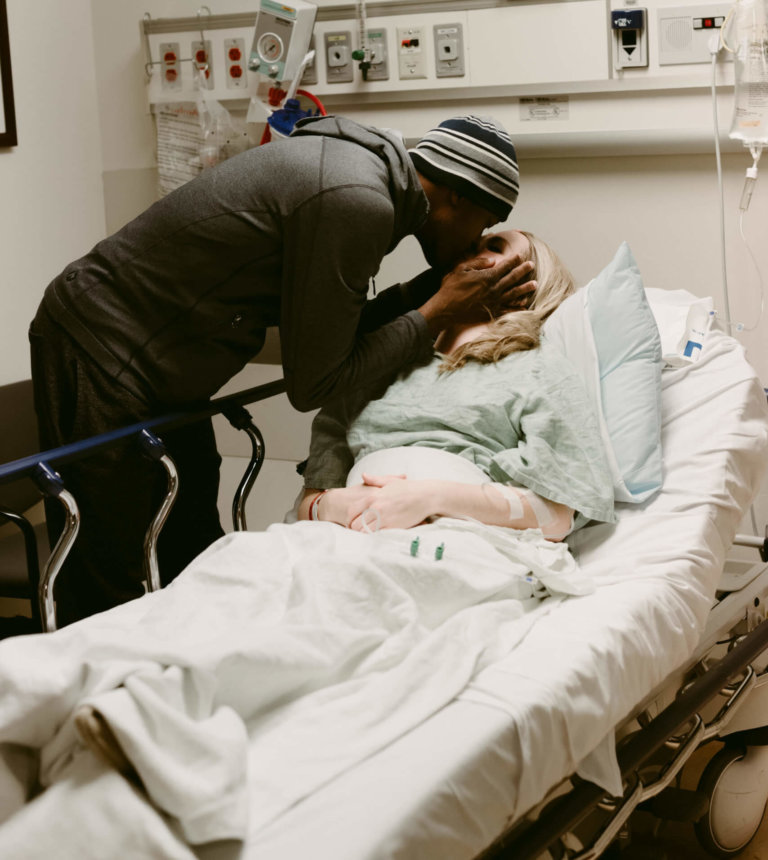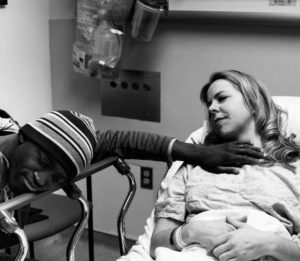
By Erin Rollins
For 10 days, faith had sustained me.
It had sustained me through the excruciating pain and panic of an ambulance ride. It had sustained me as a team of doctors and nurses moved my broken body from one machine and test to another, and through the hours-long wait for my family. It had sustained me as I listened to a doctor deliver a list of life-altering injuries: A shattered spine. A severed iliac artery. A lacerated liver. A fractured sternum. A nearly dissected rectus muscle. Holes in my bowels, colon and small intestine. Seven broken bones.
My faith had sustained me through a 7-1/2 hour laparotomy that left a two-inch-wide, two-inch-deep opening in my abdomen, and through a second, longer surgery that left me with two metal rods in my back.
Now, on Nov. 19, 2014—exactly 10 days after a wrong-way drunk driver on Interstate 55 outside of Chicago hit me head-on—my blood pressure plummeted and I became tachycardic.
I was 29 years old, and I was dying.
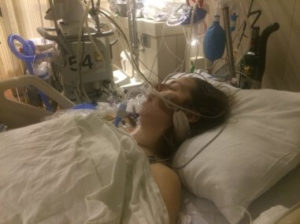
Life brimmed with possibilities before a drunk driver nearly killed me in the early morning hours of Nov. 9, 2014. I worked as a temp and digital editor for an online publication, a position the staff told me would soon go full-time. I participated as an active member within my church and remained physically active, teaching aerobics and working as a personal trainer. I’d also recently met a young man through friends, and although the relationship was new, I had already developed strong feelings for him. I felt confident in myself and hopeful about the future.
I planned to see a 9:30 p.m. movie with a friend on the last night of the life I once knew. At the last minute, another friend came over to work on my computer, and when I realized I would be late to the movie, we decided to go to the 10:40 p.m. showing instead.
I remember buying popcorn and a Diet Coke – these were treats for me – and disliking the movie so much that my friend and I both considered leaving early. By the time we stepped out into the cold night, the clock read 1 a.m. I offered my friend a ride home, but she declined, later telling me that she didn’t want me to be out on the roads longer than I had to be.
At a stoplight, I called my mom, who worried that I wasn’t home yet.

“Go back to bed,” I told her. “I’ll be home in 20 minutes.”
I have no memory of the car speeding toward me the wrong way on the interstate. I have no memory of the impact that nearly cut my body in half. Five and a half years later, those minutes are still lost to me, but the emotional memories remain. It feels like there is a TV on in the room and I can hear it and understand what is happening but I cannot see it. There is the feeling that no one is coming for me. That I can’t move. That I am suffocating. That I’m going to die all by myself.
The crash report fills in details from the scene: Firefighters arrived first, followed by two Illinois state troopers. One said he took one look at the carnage and braced himself for multiple fatalities. At 1:45 a.m., 16 minutes after the crash, paramedics arrived.
I remember being wheeled backwards into the ambulance and wondering if everything was real. The walls of the emergency vehicle seemed to close in around me. I remember looking up at the faces of the ER team trying to save my life. I remember seeing a uniformed officer at the end of my bed, and wondering what I did wrong.
Instead, the officer said: “I’m so sorry. You were hit head-on by a wrong-way drunk driver.”
The trooper walked two feet over, to another bed with a woman I had looked at and felt compassion for only minutes prior, in the same ER room as me, separated by only a curtain. I kept my eyes forward, not wanting to invade her privacy.
“Look to the woman on your right,” the trooper said to her. “That’s the woman you hit. Do you understand what you did?”
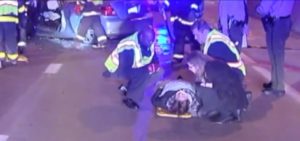
All of it felt like too much to process. My brain shut off. The reality of being so close to the woman who had done this to me—the woman responsible for pain so excruciating I screamed every time hospital staff moved me—was too much.
“Non-life-threatening injuries.” That is how the media reported my condition following the crash. Yet, any number of my injuries might have killed me. By the time the hospital staff wheeled me into the operating room for my third emergency surgery, I had minutes to live.
The surgery spared my life. It also felt very confusing to me. I had tried to be so strong, and I felt so sure that God had allowed all of this to happen for a reason, but this night shook me to the core. Death felt as close as it did on the night of the crash; in some ways, it felt even closer. Despite the doctors assuring my friends and family I would be sedated the entire night, I awoke around 2 a.m. with my arms tied to a hospital bed and an intubation tube down my throat. The opening in my abdomen was now the size of a football, impossible for surgeons to close. Doctors had also performed a stoma for a colostomy system suturing my large intestine to an incision in my abdominal wall to provide a channel for my feces to leave my body.
Immobile and unable to speak, I felt utterly broken. My sister and best friend took turns holding my hand. I silently prayed for God to come through for me.
The morning brought renewed hope. It came in the form of a surgeon I’d never met, who walked into my room, wrote his name on the board and told me he wanted to put my body back together.
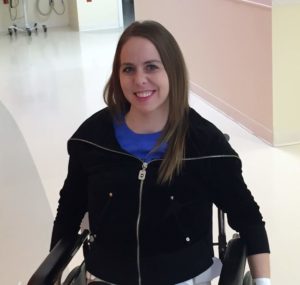
He would need to try something he never had before on a case as severe as mine, and to successfully close the gaping hole in my abdomen, I would need enough fascia—a band of connective tissue beneath the skin. Even then, he could not make any promises, and I would have to wait five days to make sure there would be no further infection, and I would be healthy enough to survive the surgery.
On the fourth day, I spiked a fever. Within two hours of my sister sending out a Facebook prayer request, my fever vanished. On the fifth day, I waited all day to be taken to surgery. My family and I prayed fervently for enough fascia. Finally, the staff rolled me into the OR for the fourth time in 15 days.
The pain afterwards took hours to manage, and recovery took twice as long as it should have. But my prayers had been answered. I had enough fascia. The surgery proved to be a major success.
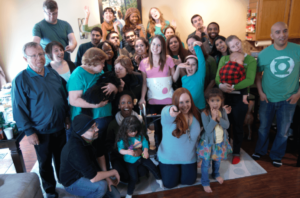
On Dec. 5, 2014, the hospital discharged me into the care of a rehabilitation facility. I lived there for the next six weeks, learning to sit up, to walk with a walker and a harness, catheterize myself every four-to-five hours, and clean and change my entire colostomy system. It took a couple of weeks to gain enough strength to transfer myself in and out of a wheelchair.
A drunk driver may not have physically killed me on Nov. 9, 2014, but she took my life. The Erin I knew no longer existed. I lost my car, my job, my independence. I lost two-thirds of my hair after doctors prescribed a nerve blocker for pain that kept me bedridden at times. The crash ravaged my body and scarred me from my ribs to groin, from the middle of my back to my tailbone, and from my left rectus muscle to almost mid-back. The weekend of my 30th birthday, I lost my love interest. He flew out from Seattle and after visiting for five days, told me he no longer felt attracted to me. I felt absolutely devastated and wondered if anyone ever would be again.
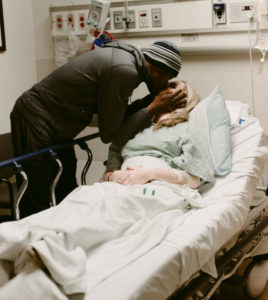
Five and a half years after the crash, I can walk, but not for very long distances. I can’t run and I dance with “two left feet.” I have to wear braces on my feet, my ankles roll, and nerve pain still plagues me. I have not recovered my bladder and bowel functions, and I wrestle with this—a physical representation of what the person who made the choice to drive drunk took from me.
My offender received an 18-month jail sentence. In many ways, I received a life sentence. My faith in God allowed me to forgive my offender in the end, to release any bitter and resentful feelings I had towards her and how her selfish actions had affected me. Forgiveness allowed me to move on with my life free of her and to advocate for others.
Don’t get me wrong: Justice and forgiveness are two separate things. I chose to forgive her while also hoping that the penalty would be enough that she will never make the same choice to drink and drive again.
I am still learning to accept the fact that I may never be as active or mobile as I was before the crash, and that my self-worth doesn’t come from having an intact stomach or being a certain size, or even fitting into a mold that the world defines as beautiful. Strength and grace are some of the qualities that have become my new definition for beauty.
Today, I am happily married to the man of my dreams. We met a year after my crash, and his ability to see past my scars and physical limitations has been life-giving. We have two dogs we love. We are saving for a house and hoping for children someday. I am learning to accept and work with the things I have while striving for something better.
And, I will never ever give up hope.
Follow Erin
To follow Erin’s blog, click here. To follow her on YouTube, click here. You can also find Erin on Instagram at PeeingIsOverratedTheFilm and on Facebook at Peeing Is Overrated: The Untold Story of “The Miracle Patient.”

